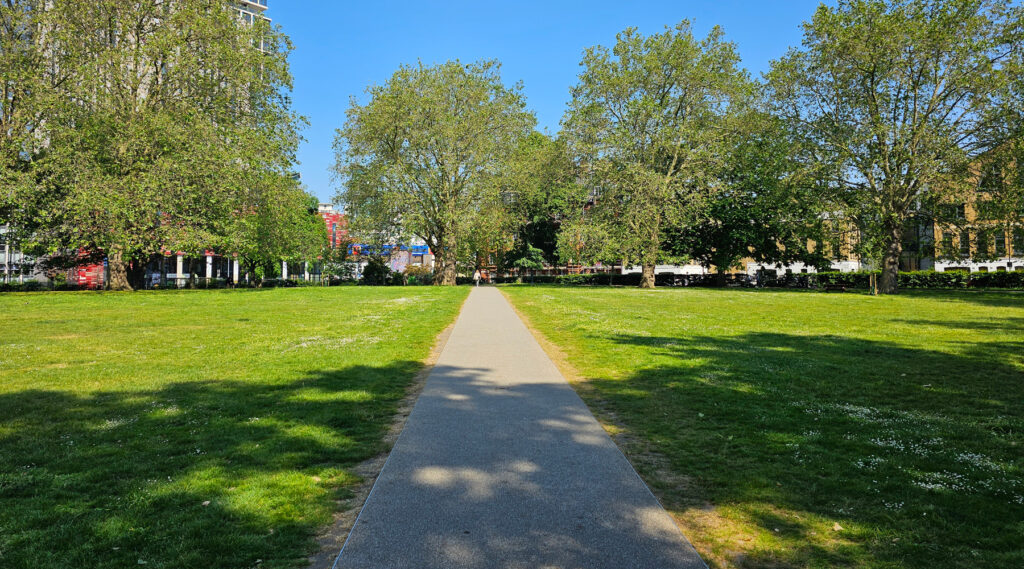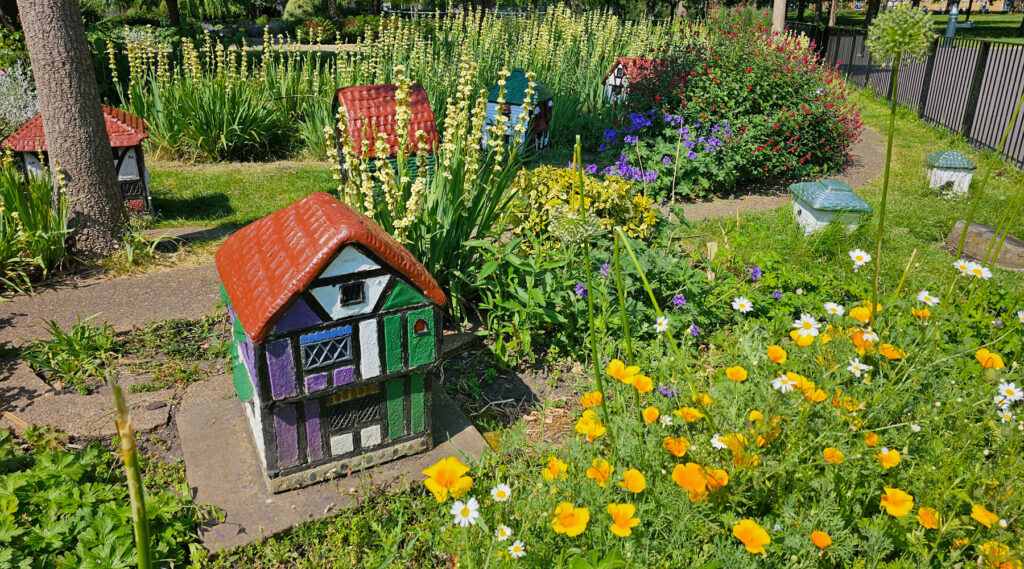This is a park to the south of Vauxhall station created in the 1880s following campaigns that people living in the increasingly dirty city should have access to public parks.
The area was still mostly undeveloped until the 1800s, but by the 1820s, the first block of houses had appeared in the middle of where the park is today. The houses had very large, I mean, really very large back gardens, which probably helped prevent too much dense housing from being built in the area, whereas much of the area around what was to become the park was filling up with close-packed Victorian terraces.
To the south, by the 1870s was the Dutch Ambassador’s residence, Caroun House and a large field, but other than that, the land that was to become Vauxhall Park was unusual in having very few occupants, all with large gardens.
However, that was nearly not the case – as the row of decent-sized houses on The Lawn was being demolished in 1887, and likely to be developed into smaller houses by a property developer, Mr Cobeldick, who had been buying up the houses, and that provoked an attempt to buy the land and open it as a park.
Part of the impetus was the legacy of one of the occupants of the houses on The Lawn, Henry Fawcett, a politician and campaigner for women’s rights and poverty relief. He died in 1884 in his home, and there was some talk of turning his home into a museum.
However, with a large plot and few occupants, a campaign was set up to buy the houses and turn the area into a public park, supported by Henry Fawcett’s widow. It took a few years, with the earliest reference to the campaign from 1887, and fundraising still under way in 1889.
The Kyrle Society led the campaign, securing the support of many leading members of society, and supported by the social reformer Octavia Hill.
Thanks to their efforts, by January 1889 the Metropolitan Board of Works, the local vestry and the Charity Commissioners had pledged £36,000 and local fundraising had raised another £5,890. With pledges of £2,000, in January 1889 they needed just another £1,370 to be able to buy the land.
Then they would need to raise more money to cover the cost of laying out the park. In total, they would need £43,000 to buy the land and lay it out as a park.
But they succeeded.
On Monday 7th July 1890 the Prince and Princess of Wales formally opened Vauxhall Park to the public.
A few years later, in June 1893, a statue of Henry Fawcett was added to the park – roughly where his house had stood. It seems that the house still stood when the park opened, but was later demolished to make more space for the park and the statue added. However, it was removed by Lambeth Council in 1959 and has since been replaced by a plaque.
One other legacy of the later demolition of Fawcett House was that the surplus from selling off the building materials was used to pay for the drinking fountain that’s in the park, and still there.
The name of the other houses that were demolished, The Lawn, has been preserved in the name of the park’s new northern boundary road, Lawn Lane. Today, it’s still a decent sized park that still has airs of its Victorian origins with modern adjustments. Looked after by Lambeth council, there is also a friends society which supports the park.
Much of the area that had been The Lawns houses is an open lawn space, quite appropriately it seems to me, so when you stand in the open lawn, you’re standing where large private back gardens used to be.
The site of the former ambassador’s house was originally laid out as a park, but is now the tennis courts, while the one plot that was still fields at the time the park was created is now a mix of a laid out garden, but also long rows of lavender plants.
The other notable feature of the park is that while it was built on land cleared from houses, it now has its own miniature houses – a model village.
The model village was created by Edgar Wilson, who created it in 1947, using surplus houses from a model village in Brockwell Park. Initially, it stood in an open lawn space, surrounded by a fence, but these days the grass has been replaced with denser floral planting, which can make the village harder to spot. However, I prefer it this way as it’s more magical and faerie like now.














Curiosity piqued by your account of the disappearing statue of Henry Fawcett, I discovered this
https://vauxhallhistory.org/henry-fawcett-missing-monument/
Sadly, I remember well, growing up in Birmingham, how Victorian Art, architecture and furniture was despised by the powers-that-be.
You mean the very famous Millicent Fawcett women’s suffragist leader – who now has her statue in Parliament Square
I love this park. It had a makeover about 5 years ago, I thought the money may have come, partly, from American Embassy related funds? It has a brilliant kids’ playground – would have passed for a funfair when I was a kid. In the gorgeous enclosed garden, beautiful shrubs and trees, sundials too. Mustn’t leave out the rows of lavender. All carefully tended to by the nice gardener man who reminds me a little of the BFG.
Thanks for the nice piece, Ian. I am a Trustee of the Friends of Vauxhall Park. The fountain you show is actually just an ornamental fountain. If you go on the FOVP Instagram account (vauxhallparkfriends) you can see a photo of the Doulton fountain, sadly long gone, in a post on 21/5/22. The new drinking fountains can fill up drinking bottles, hydrate dogs and people! The statue of Henry Fawcett had Doulton pottery panels on the side representing Fawcett’s achievements, by Doulton’s master designer, George Tinworth (who worked at Doulton’s factory on nearby Black Prince Rd). A tragedy that it was demolished. Millicent Fawcett led the campaign to create the park to fulfil Henry’s wish that the people of Vauxhall had access to open space amid the pollution created by industry in the area.